Abstract
This paper summarizes the clinical phenomenology of multiple chemical sensitivity (MCS), outlines the concepts and evidence for the olfactory-limbic, neural sensitization model for MCS, and discusses experimental design implications of the model for exposure-related research. Neural sensitization is the progressive amplification of responsivity by the passage of time between repeated, intermittent exposures. Initiation of sensitization may require single toxic or multiple subtoxic exposures, but subsequent elicitation of sensitized responses can involve low or nontoxic levels. Thus, neural sensitization could account for the ability of low levels of environmental chemicals to elicit clinically severe, adverse reactions in MCS. Different forms of sensitization include limbic kindling of seizures (compare temporal lobe epilepsy and simple partial seizures) and time-dependent sensitization of behavioral, neurochemical, immunological, and endocrinological variables. Sensitized dysfunction of the limbic and mesolimbic systems could account in part for many of the cognitive, affective, and somatic symptoms in MCS. Derealization (an alteration in perception making familiar objects or people seem unfamiliar or unreal) is a common MCS symptom and has been linked with limbic dysfunction in clinical neuroscience research. Sensitization is distinct from, but interactive with, other neurobiological learning and memory processes such as conditioning and habituation (compare adaptation or tolerance). In previous studies, hypotheses for MCS involving sensitization, conditioning, and habituation (adaptation) have often been considered in isolation from one another. To design more appropriate chemical exposure studies, it may be important to integrate the various theoretical models and empirical approaches to MCS with the larger scientific literature on individual differences in these potentially interactive phenomena.
Full text
PDF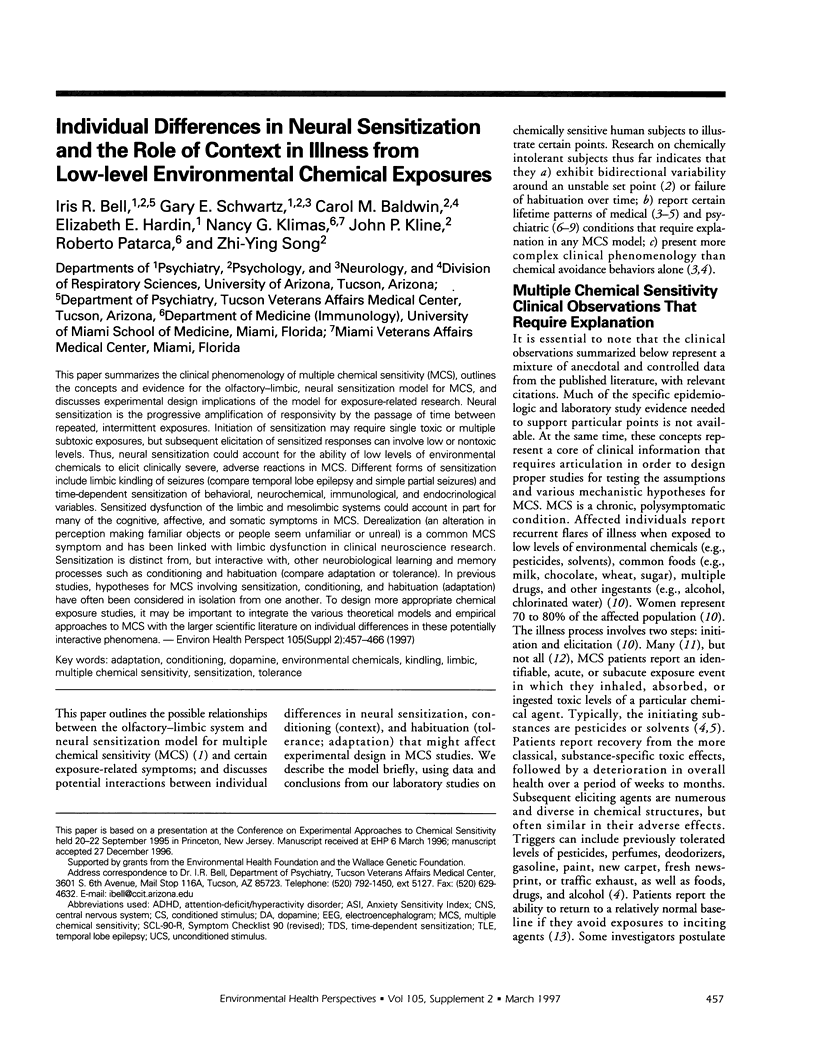
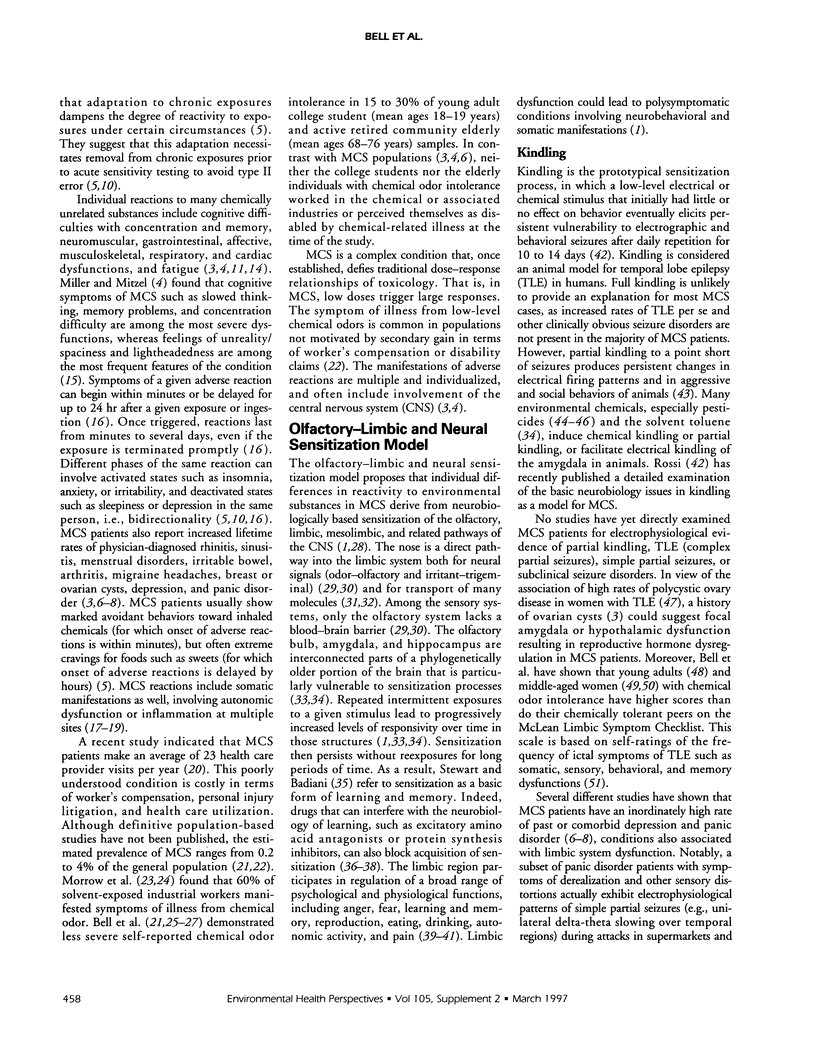
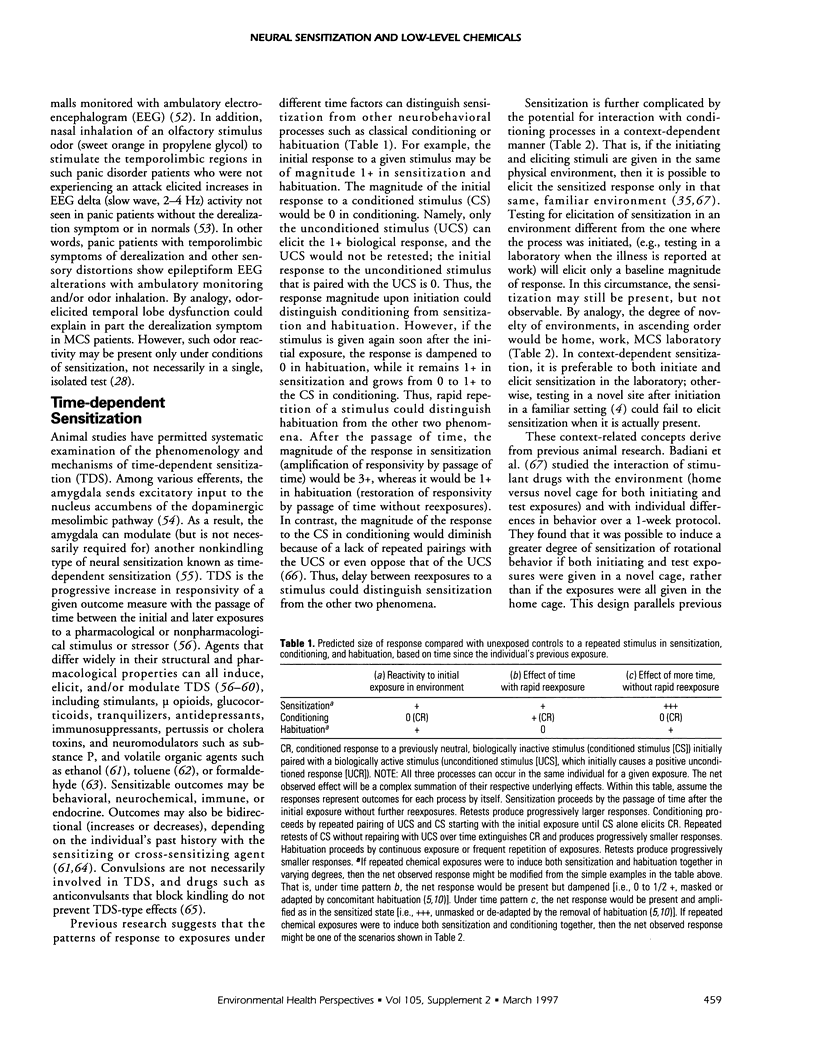
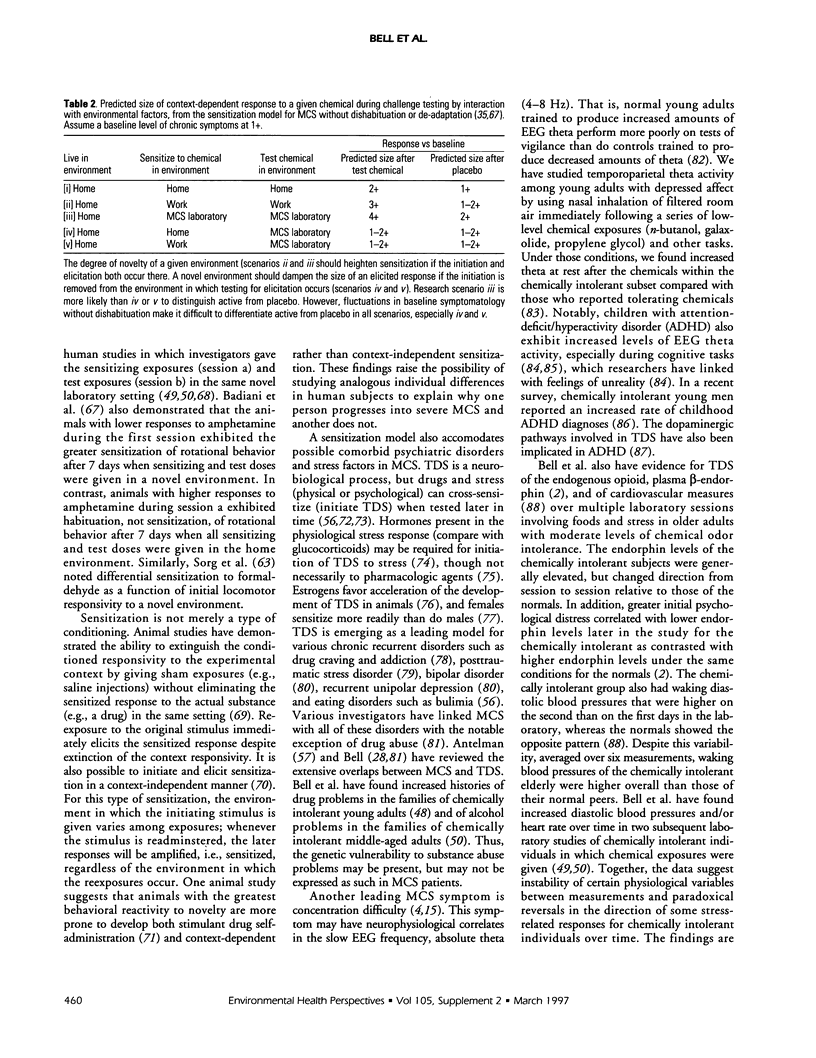
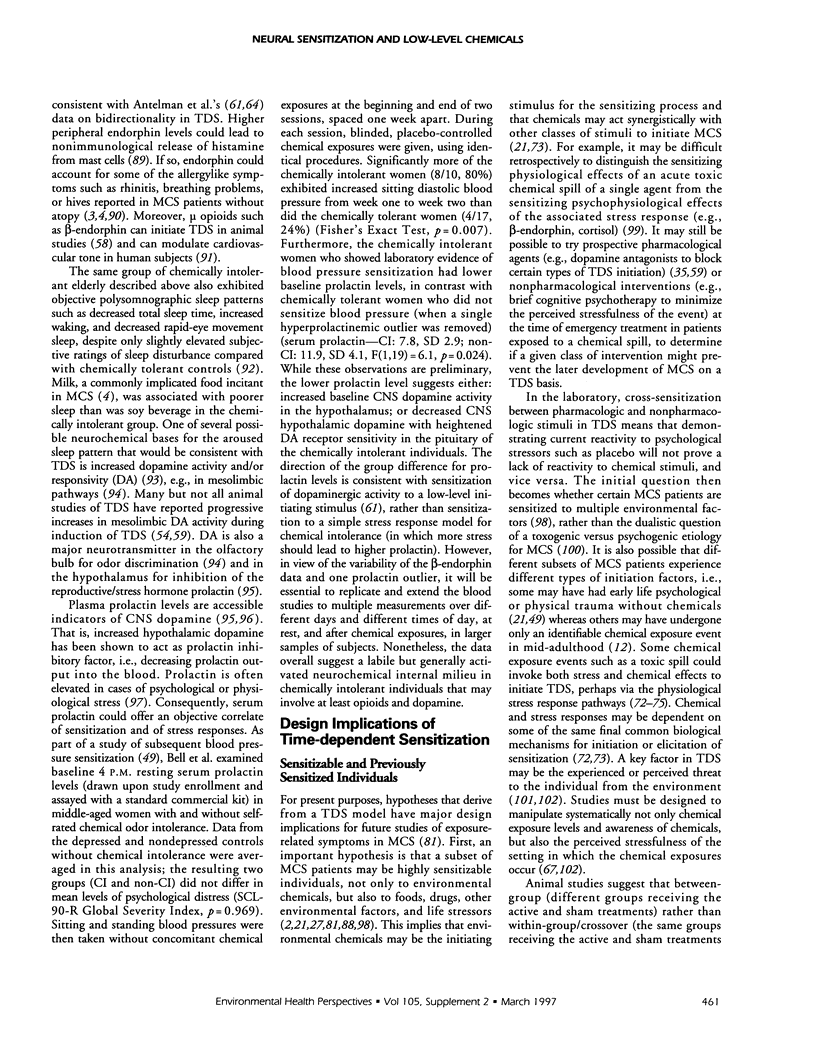
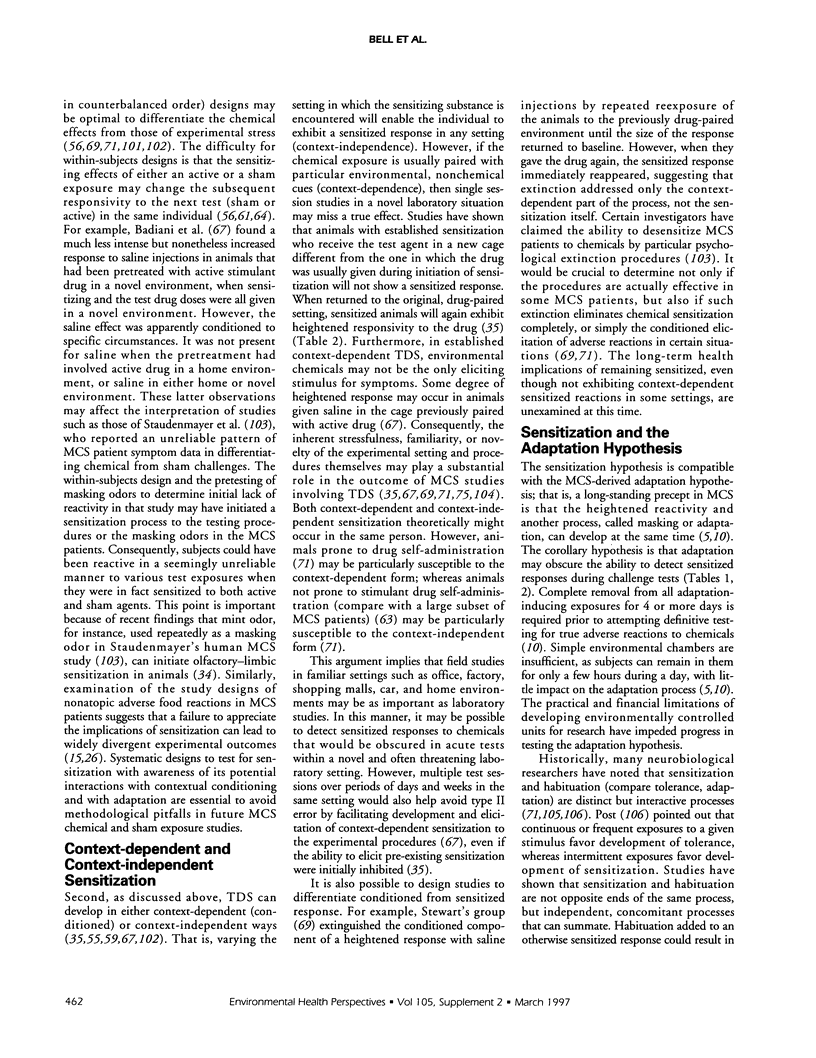
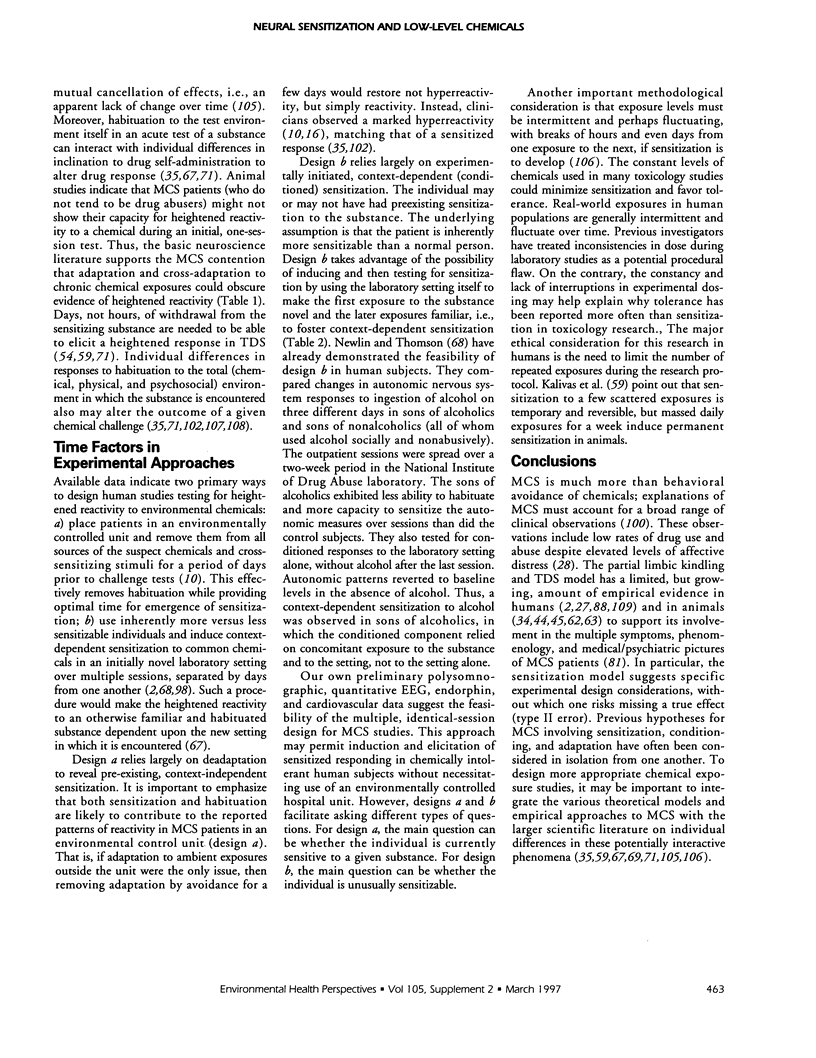
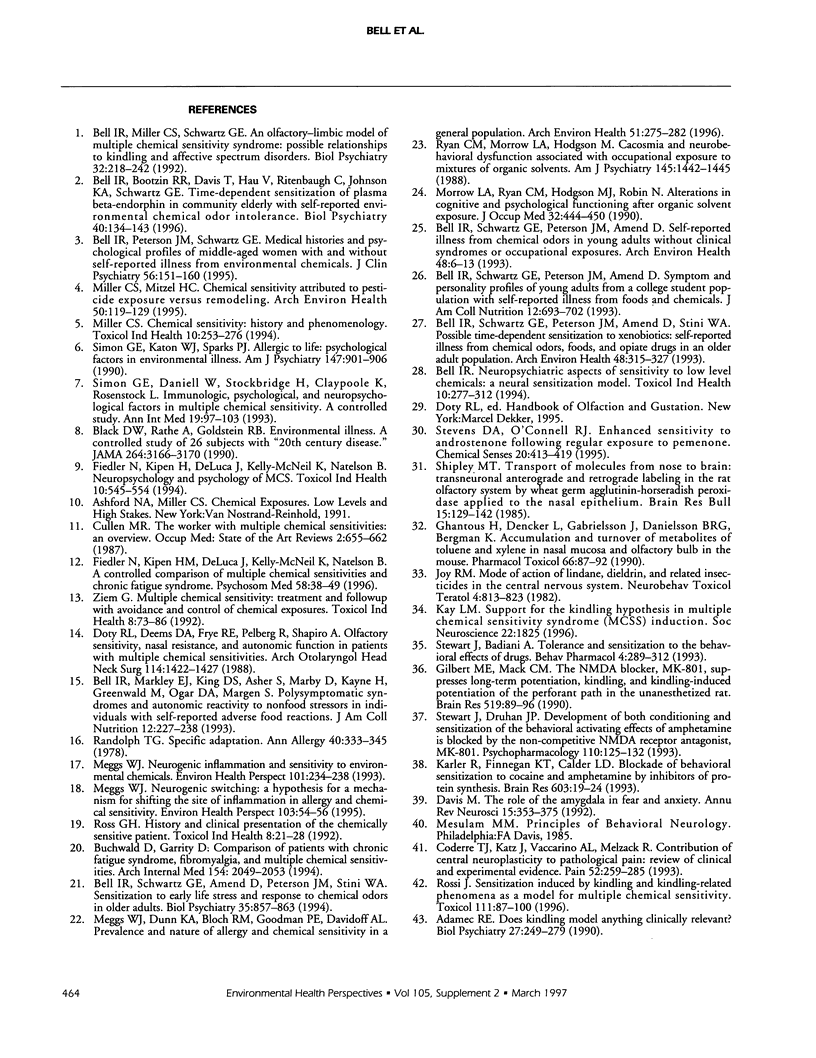
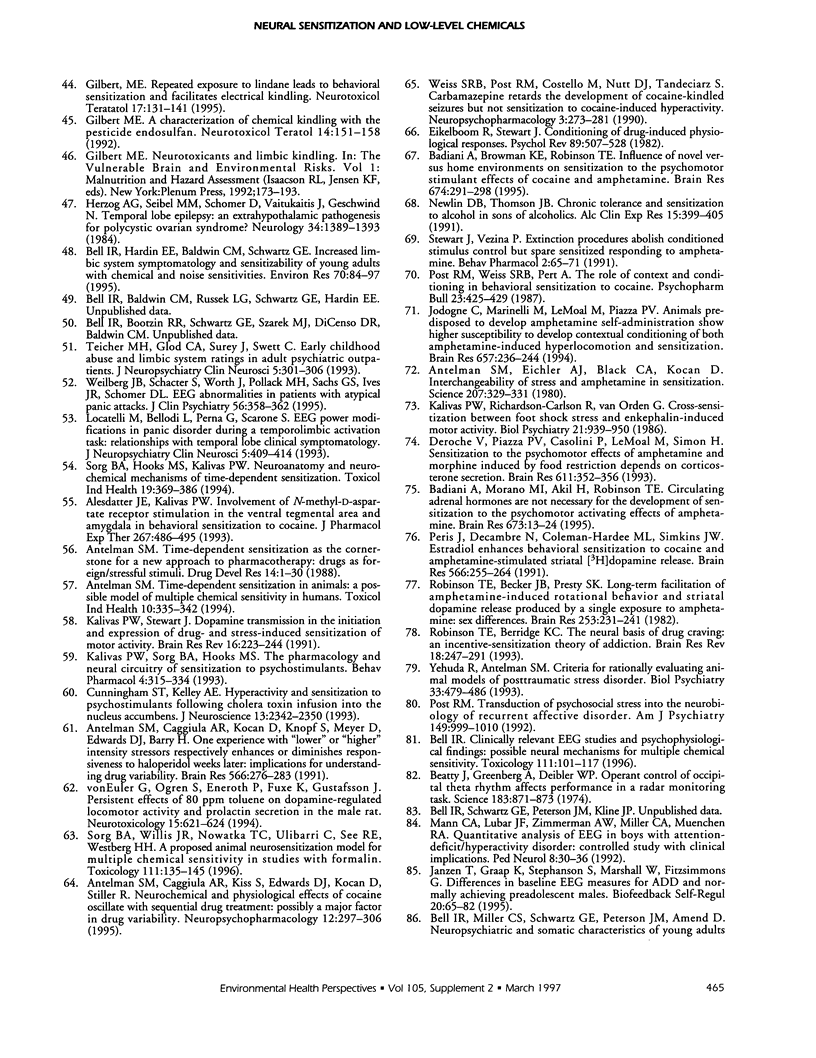
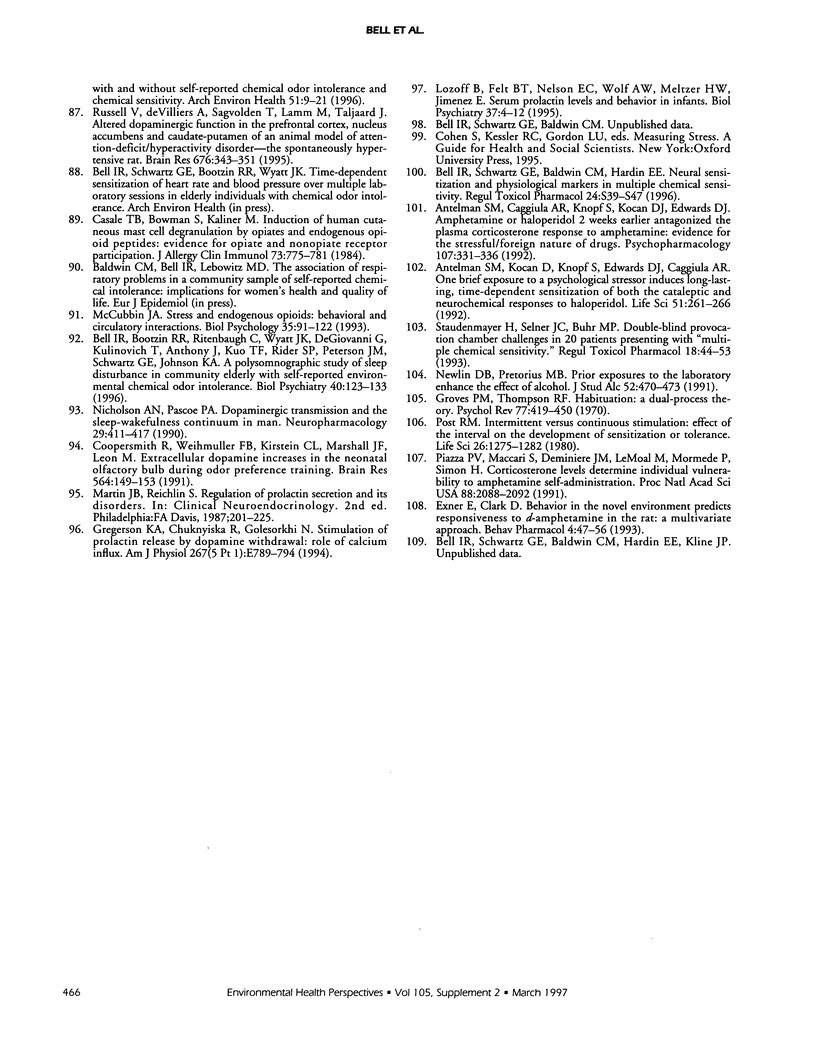
Selected References
These references are in PubMed. This may not be the complete list of references from this article.
- Adamec R. E. Does kindling model anything clinically relevant? Biol Psychiatry. 1990 Feb 1;27(3):249–279. doi: 10.1016/0006-3223(90)90001-i. [DOI] [PubMed] [Google Scholar]
- Antelman S. M., Caggiula A. R., Kiss S., Edwards D. J., Kocan D., Stiller R. Neurochemical and physiological effects of cocaine oscillate with sequential drug treatment: possibly a major factor in drug variability. Neuropsychopharmacology. 1995 Jul;12(4):297–306. doi: 10.1016/0893-133X(94)00094-G. [DOI] [PubMed] [Google Scholar]
- Antelman S. M., Caggiula A. R., Knopf S., Kocan D. J., Edwards D. J. Amphetamine or haloperidol 2 weeks earlier antagonized the plasma corticosterone response to amphetamine; evidence for the stressful/foreign nature of drugs. Psychopharmacology (Berl) 1992;107(2-3):331–336. doi: 10.1007/BF02245157. [DOI] [PubMed] [Google Scholar]
- Antelman S. M., Caggiula A. R., Kocan D., Knopf S., Meyer D., Edwards D. J., Barry H., 3rd One experience with 'lower' or 'higher' intensity stressors, respectively enhances or diminishes responsiveness to haloperidol weeks later: implications for understanding drug variability. Brain Res. 1991 Dec 6;566(1-2):276–283. doi: 10.1016/0006-8993(91)91709-a. [DOI] [PubMed] [Google Scholar]
- Antelman S. M., Eichler A. J., Black C. A., Kocan D. Interchangeability of stress and amphetamine in sensitization. Science. 1980 Jan 18;207(4428):329–331. doi: 10.1126/science.7188649. [DOI] [PubMed] [Google Scholar]
- Antelman S. M., Kocan D., Knopf S., Edwards D. J., Caggiula A. R. One brief exposure to a psychological stressor induces long-lasting, time-dependent sensitization of both the cataleptic and neurochemical responses to haloperidol. Life Sci. 1992;51(4):261–266. doi: 10.1016/0024-3205(92)90084-3. [DOI] [PubMed] [Google Scholar]
- Antelman S. M. Time-dependent sensitization in animals: a possible model of multiple chemical sensitivity in humans. Toxicol Ind Health. 1994 Jul-Oct;10(4-5):335–342. [PubMed] [Google Scholar]
- Badiani A., Browman K. E., Robinson T. E. Influence of novel versus home environments on sensitization to the psychomotor stimulant effects of cocaine and amphetamine. Brain Res. 1995 Mar 20;674(2):291–298. doi: 10.1016/0006-8993(95)00028-o. [DOI] [PubMed] [Google Scholar]
- Badiani A., Morano M. I., Akil H., Robinson T. E. Circulating adrenal hormones are not necessary for the development of sensitization to the psychomotor activating effects of amphetamine. Brain Res. 1995 Feb 27;673(1):13–24. doi: 10.1016/0006-8993(94)01365-o. [DOI] [PubMed] [Google Scholar]
- Beatty J., Greenberg A., Deibler W. P., O'Hanlon J. F. Operant control of occipital theta rhythm affects performance in a radar monitoring task. Science. 1974 Mar 1;183(4127):871–873. doi: 10.1126/science.183.4127.871. [DOI] [PubMed] [Google Scholar]
- Bell I. R., Bootzin R. R., Davis T. P., Hau V., Ritenbaugh C., Johnson K. A., Schwartz G. E. Time-dependent sensitization of plasma beta-endorphin in community elderly with self-reported environmental chemical odor intolerance. Biol Psychiatry. 1996 Jul 15;40(2):134–143. doi: 10.1016/0006-3223(95)00331-2. [DOI] [PubMed] [Google Scholar]
- Bell I. R., Bootzin R. R., Ritenbaugh C., Wyatt J. K., DeGiovanni G., Kulinovich T., Anthony J. L., Kuo T. F., Rider S. P., Peterson J. M. A polysomnographic study of sleep disturbance in community elderly with self-reported environmental chemical odor intolerance. Biol Psychiatry. 1996 Jul 15;40(2):123–133. doi: 10.1016/0006-3223(95)00330-4. [DOI] [PubMed] [Google Scholar]
- Bell I. R. Clinically relevant EEG studies and psychophysiological findings: possible neural mechanisms for multiple chemical sensitivity. Toxicology. 1996 Jul 17;111(1-3):101–117. doi: 10.1016/0300-483x(96)03395-1. [DOI] [PubMed] [Google Scholar]
- Bell I. R., Hardin E. E., Baldwin C. M., Schwartz G. E. Increased limbic system symptomatology and sensitizability of young adults with chemical and noise sensitivities. Environ Res. 1995 Aug;70(2):84–97. doi: 10.1006/enrs.1995.1052. [DOI] [PubMed] [Google Scholar]
- Bell I. R., Markley E. J., King D. S., Asher S., Marby D., Kayne H., Greenwald M., Ogar D. A., Margen S. Polysymptomatic syndromes and autonomic reactivity to nonfood stressors in individuals with self-reported adverse food reactions. J Am Coll Nutr. 1993 Jun;12(3):227–238. doi: 10.1080/07315724.1993.10718304. [DOI] [PubMed] [Google Scholar]
- Bell I. R., Miller C. S., Schwartz G. E. An olfactory-limbic model of multiple chemical sensitivity syndrome: possible relationships to kindling and affective spectrum disorders. Biol Psychiatry. 1992 Aug 1;32(3):218–242. doi: 10.1016/0006-3223(92)90105-9. [DOI] [PubMed] [Google Scholar]
- Bell I. R., Miller C. S., Schwartz G. E., Peterson J. M., Amend D. Neuropsychiatric and somatic characteristics of young adults with and without self-reported chemical odor intolerance and chemical sensitivity. Arch Environ Health. 1996 Jan-Feb;51(1):9–21. doi: 10.1080/00039896.1996.9935987. [DOI] [PubMed] [Google Scholar]
- Bell I. R., Peterson J. M., Schwartz G. E. Medical histories and psychological profiles of middle-aged women with and without self-reported illness from environmental chemicals. J Clin Psychiatry. 1995 Apr;56(4):151–160. [PubMed] [Google Scholar]
- Bell I. R., Schwartz G. E., Amend D., Peterson J. M., Stini W. A. Sensitization to early life stress and response to chemical odors in older adults. Biol Psychiatry. 1994 Jun 1;35(11):857–863. doi: 10.1016/0006-3223(94)90021-3. [DOI] [PubMed] [Google Scholar]
- Bell I. R., Schwartz G. E., Baldwin C. M., Hardin E. E. Neural sensitization and physiological markers in multiple chemical sensitivity. Regul Toxicol Pharmacol. 1996 Aug;24(1 Pt 2):S39–S47. doi: 10.1006/rtph.1996.0075. [DOI] [PubMed] [Google Scholar]
- Bell I. R., Schwartz G. E., Peterson J. M., Amend D. Self-reported illness from chemical odors in young adults without clinical syndromes or occupational exposures. Arch Environ Health. 1993 Jan-Feb;48(1):6–13. doi: 10.1080/00039896.1993.9938387. [DOI] [PubMed] [Google Scholar]
- Bell I. R., Schwartz G. E., Peterson J. M., Amend D., Stini W. A. Possible time-dependent sensitization to xenobiotics: self-reported illness from chemical odors, foods, and opiate drugs in an older adult population. Arch Environ Health. 1993 Sep-Oct;48(5):315–327. doi: 10.1080/00039896.1993.9936720. [DOI] [PubMed] [Google Scholar]
- Bell I. R., Schwartz G. E., Peterson J. M., Amend D. Symptom and personality profiles of young adults from a college student population with self-reported illness from foods and chemicals. J Am Coll Nutr. 1993 Dec;12(6):693–702. doi: 10.1080/07315724.1993.10718361. [DOI] [PubMed] [Google Scholar]
- Bell I. R. White paper: Neuropsychiatric aspects of sensitivity to low-level chemicals: a neural sensitization model. Toxicol Ind Health. 1994 Jul-Oct;10(4-5):277–312. [PubMed] [Google Scholar]
- Black D. W., Rathe A., Goldstein R. B. Environmental illness. A controlled study of 26 subjects with '20th century disease'. JAMA. 1990 Dec 26;264(24):3166–3170. doi: 10.1001/jama.264.24.3166. [DOI] [PubMed] [Google Scholar]
- Buchwald D., Garrity D. Comparison of patients with chronic fatigue syndrome, fibromyalgia, and multiple chemical sensitivities. Arch Intern Med. 1994 Sep 26;154(18):2049–2053. [PubMed] [Google Scholar]
- Casale T. B., Bowman S., Kaliner M. Induction of human cutaneous mast cell degranulation by opiates and endogenous opioid peptides: evidence for opiate and nonopiate receptor participation. J Allergy Clin Immunol. 1984 Jun;73(6):775–781. doi: 10.1016/0091-6749(84)90447-0. [DOI] [PubMed] [Google Scholar]
- Coderre T. J., Katz J., Vaccarino A. L., Melzack R. Contribution of central neuroplasticity to pathological pain: review of clinical and experimental evidence. Pain. 1993 Mar;52(3):259–285. doi: 10.1016/0304-3959(93)90161-H. [DOI] [PubMed] [Google Scholar]
- Coopersmith R., Weihmuller F. B., Kirstein C. L., Marshall J. F., Leon M. Extracellular dopamine increases in the neonatal olfactory bulb during odor preference training. Brain Res. 1991 Nov 8;564(1):149–153. doi: 10.1016/0006-8993(91)91365-8. [DOI] [PubMed] [Google Scholar]
- Cullen M. R. The worker with multiple chemical sensitivities: an overview. Occup Med. 1987 Oct-Dec;2(4):655–661. [PubMed] [Google Scholar]
- Cunningham S. T., Kelley A. E. Hyperactivity and sensitization to psychostimulants following cholera toxin infusion into the nucleus accumbens. J Neurosci. 1993 Jun;13(6):2342–2350. doi: 10.1523/JNEUROSCI.13-06-02342.1993. [DOI] [PMC free article] [PubMed] [Google Scholar]
- Davis M. The role of the amygdala in fear and anxiety. Annu Rev Neurosci. 1992;15:353–375. doi: 10.1146/annurev.ne.15.030192.002033. [DOI] [PubMed] [Google Scholar]
- Deroche V., Piazza P. V., Casolini P., Le Moal M., Simon H. Sensitization to the psychomotor effects of amphetamine and morphine induced by food restriction depends on corticosterone secretion. Brain Res. 1993 May 21;611(2):352–356. doi: 10.1016/0006-8993(93)90526-s. [DOI] [PubMed] [Google Scholar]
- Doty R. L., Deems D. A., Frye R. E., Pelberg R., Shapiro A. Olfactory sensitivity, nasal resistance, and autonomic function in patients with multiple chemical sensitivities. Arch Otolaryngol Head Neck Surg. 1988 Dec;114(12):1422–1427. doi: 10.1001/archotol.1988.01860240072027. [DOI] [PubMed] [Google Scholar]
- Eikelboom R., Stewart J. Conditioning of drug-induced physiological responses. Psychol Rev. 1982 Sep;89(5):507–528. [PubMed] [Google Scholar]
- Exner M., Clark D. Behaviour in the novel environment predicts responsiveness to d-amphetamine in the rat: a multivariate approach. Behav Pharmacol. 1993 Feb;4(1):47–56. [PubMed] [Google Scholar]
- Fiedler N., Kipen H. M., DeLuca J., Kelly-McNeil K., Natelson B. A controlled comparison of multiple chemical sensitivities and chronic fatigue syndrome. Psychosom Med. 1996 Jan-Feb;58(1):38–49. doi: 10.1097/00006842-199601000-00007. [DOI] [PubMed] [Google Scholar]
- Fiedler N., Kipen H., Deluca J., Kelly-McNeil K., Natelson B. Neuropsychology and psychology of MCS. Toxicol Ind Health. 1994 Jul-Oct;10(4-5):545–554. [PubMed] [Google Scholar]
- Ghantous H., Dencker L., Gabrielsson J., Danielsson B. R., Bergman K. Accumulation and turnover of metabolites of toluene and xylene in nasal mucosa and olfactory bulb in the mouse. Pharmacol Toxicol. 1990 Feb;66(2):87–92. doi: 10.1111/j.1600-0773.1990.tb00711.x. [DOI] [PubMed] [Google Scholar]
- Gilbert M. E. A characterization of chemical kindling with the pesticide endosulfan. Neurotoxicol Teratol. 1992 Mar-Apr;14(2):151–158. doi: 10.1016/0892-0362(92)90063-g. [DOI] [PubMed] [Google Scholar]
- Gilbert M. E., Mack C. M. The NMDA antagonist, MK-801, suppresses long-term potentiation, kindling, and kindling-induced potentiation in the perforant path of the unanesthetized rat. Brain Res. 1990 Jun 11;519(1-2):89–96. doi: 10.1016/0006-8993(90)90064-i. [DOI] [PubMed] [Google Scholar]
- Gilbert M. E. Repeated exposure to lindane leads to behavioral sensitization and facilitates electrical kindling. Neurotoxicol Teratol. 1995 Mar-Apr;17(2):131–141. doi: 10.1016/0892-0362(94)00064-k. [DOI] [PubMed] [Google Scholar]
- Gregerson K. A., Chuknyiska R., Golesorkhi N. Stimulation of prolactin release by dopamine withdrawal: role of calcium influx. Am J Physiol. 1994 Nov;267(5 Pt 1):E789–E794. doi: 10.1152/ajpendo.1994.267.5.E789. [DOI] [PubMed] [Google Scholar]
- Groves P. M., Thompson R. F. Habituation: a dual-process theory. Psychol Rev. 1970 Sep;77(5):419–450. doi: 10.1037/h0029810. [DOI] [PubMed] [Google Scholar]
- Herzog A. G., Seibel M. M., Schomer D., Vaitukaitis J., Geschwind N. Temporal lobe epilepsy: an extrahypothalamic pathogenesis for polycystic ovarian syndrome? Neurology. 1984 Oct;34(10):1389–1393. doi: 10.1212/wnl.34.10.1389. [DOI] [PubMed] [Google Scholar]
- Janzen T., Graap K., Stephanson S., Marshall W., Fitzsimmons G. Differences in baseline EEG measures for ADD and normally achieving preadolescent males. Biofeedback Self Regul. 1995 Mar;20(1):65–82. doi: 10.1007/BF01712767. [DOI] [PubMed] [Google Scholar]
- Jodogne C., Marinelli M., Le Moal M., Piazza P. V. Animals predisposed to develop amphetamine self-administration show higher susceptibility to develop contextual conditioning of both amphetamine-induced hyperlocomotion and sensitization. Brain Res. 1994 Sep 19;657(1-2):236–244. doi: 10.1016/0006-8993(94)90973-3. [DOI] [PubMed] [Google Scholar]
- Joy R. M. Mode of action of lindane, dieldrin and related insecticides in the central nervous system. Neurobehav Toxicol Teratol. 1982 Nov-Dec;4(6):813–823. [PubMed] [Google Scholar]
- Kalivas P. W., Alesdatter J. E. Involvement of N-methyl-D-aspartate receptor stimulation in the ventral tegmental area and amygdala in behavioral sensitization to cocaine. J Pharmacol Exp Ther. 1993 Oct;267(1):486–495. [PubMed] [Google Scholar]
- Kalivas P. W., Richardson-Carlson R., Van Orden G. Cross-sensitization between foot shock stress and enkephalin-induced motor activity. Biol Psychiatry. 1986 Aug;21(10):939–950. doi: 10.1016/0006-3223(86)90268-4. [DOI] [PubMed] [Google Scholar]
- Kalivas P. W., Stewart J. Dopamine transmission in the initiation and expression of drug- and stress-induced sensitization of motor activity. Brain Res Brain Res Rev. 1991 Sep-Dec;16(3):223–244. doi: 10.1016/0165-0173(91)90007-u. [DOI] [PubMed] [Google Scholar]
- Kalivas P.W., Sorg B.A., Hooks M.S. The pharmacology and neural circuitry of sensitization to psychostimulants. Behav Pharmacol. 1993;4(4):315–334. [PubMed] [Google Scholar]
- Karler R., Finnegan K. T., Calder L. D. Blockade of behavioral sensitization to cocaine and amphetamine by inhibitors of protein synthesis. Brain Res. 1993 Feb 12;603(1):19–24. doi: 10.1016/0006-8993(93)91294-3. [DOI] [PubMed] [Google Scholar]
- Locatelli M., Bellodi L., Perna G., Scarone S. EEG power modifications in panic disorder during a temporolimbic activation task: relationships with temporal lobe clinical symptomatology. J Neuropsychiatry Clin Neurosci. 1993 Fall;5(4):409–414. doi: 10.1176/jnp.5.4.409. [DOI] [PubMed] [Google Scholar]
- Lozoff B., Felt B. T., Nelson E. C., Wolf A. W., Meltzer H. W., Jimenez E. Serum prolactin levels and behavior in infants. Biol Psychiatry. 1995 Jan 1;37(1):4–12. doi: 10.1016/0006-3223(94)00148-V. [DOI] [PubMed] [Google Scholar]
- Meggs W. J., Dunn K. A., Bloch R. M., Goodman P. E., Davidoff A. L. Prevalence and nature of allergy and chemical sensitivity in a general population. Arch Environ Health. 1996 Jul-Aug;51(4):275–282. doi: 10.1080/00039896.1996.9936026. [DOI] [PubMed] [Google Scholar]
- Meggs W. J. Neurogenic inflammation and sensitivity to environmental chemicals. Environ Health Perspect. 1993 Aug;101(3):234–238. doi: 10.1289/ehp.93101234. [DOI] [PMC free article] [PubMed] [Google Scholar]
- Meggs W. J. Neurogenic switching: a hypothesis for a mechanism for shifting the site of inflammation in allergy and chemical sensitivity. Environ Health Perspect. 1995 Jan;103(1):54–56. doi: 10.1289/ehp.9510354. [DOI] [PMC free article] [PubMed] [Google Scholar]
- Miller C. S., Mitzel H. C. Chemical sensitivity attributed to pesticide exposure versus remodeling. Arch Environ Health. 1995 Mar-Apr;50(2):119–129. doi: 10.1080/00039896.1995.9940889. [DOI] [PubMed] [Google Scholar]
- Miller C. S. White paper: Chemical sensitivity: history and phenomenology. Toxicol Ind Health. 1994 Jul-Oct;10(4-5):253–276. [PubMed] [Google Scholar]
- Morrow L. A., Ryan C. M., Hodgson M. J., Robin N. Alterations in cognitive and psychological functioning after organic solvent exposure. J Occup Med. 1990 May;32(5):444–450. doi: 10.1097/00043764-199005000-00010. [DOI] [PubMed] [Google Scholar]
- Newlin D. B., Pretorius M. B. Prior exposures to the laboratory enhance the effect of alcohol. J Stud Alcohol. 1991 Sep;52(5):470–473. doi: 10.15288/jsa.1991.52.470. [DOI] [PubMed] [Google Scholar]
- Newlin D. B., Thomson J. B. Chronic tolerance and sensitization to alcohol in sons of alcoholics. Alcohol Clin Exp Res. 1991 Jun;15(3):399–405. doi: 10.1111/j.1530-0277.1991.tb00537.x. [DOI] [PubMed] [Google Scholar]
- Nicholson A. N., Pascoe P. A. Dopaminergic transmission and the sleep-wakefulness continuum in man. Neuropharmacology. 1990 Apr;29(4):411–417. doi: 10.1016/0028-3908(90)90101-v. [DOI] [PubMed] [Google Scholar]
- Peris J., Decambre N., Coleman-Hardee M. L., Simpkins J. W. Estradiol enhances behavioral sensitization to cocaine and amphetamine-stimulated striatal [3H]dopamine release. Brain Res. 1991 Dec 6;566(1-2):255–264. doi: 10.1016/0006-8993(91)91706-7. [DOI] [PubMed] [Google Scholar]
- Piazza P. V., Maccari S., Deminière J. M., Le Moal M., Mormède P., Simon H. Corticosterone levels determine individual vulnerability to amphetamine self-administration. Proc Natl Acad Sci U S A. 1991 Mar 15;88(6):2088–2092. doi: 10.1073/pnas.88.6.2088. [DOI] [PMC free article] [PubMed] [Google Scholar]
- Post R. M. Intermittent versus continuous stimulation: effect of time interval on the development of sensitization or tolerance. Life Sci. 1980 Apr 21;26(16):1275–1282. doi: 10.1016/0024-3205(80)90085-5. [DOI] [PubMed] [Google Scholar]
- Post R. M. Transduction of psychosocial stress into the neurobiology of recurrent affective disorder. Am J Psychiatry. 1992 Aug;149(8):999–1010. doi: 10.1176/ajp.149.8.999. [DOI] [PubMed] [Google Scholar]
- Post R. M., Weiss S. R., Pert A. The role of context and conditioning in behavioral sensitization to cocaine. Psychopharmacol Bull. 1987;23(3):425–429. [PubMed] [Google Scholar]
- Randolph T. G. Specific adaptation. Ann Allergy. 1978 May;40(5):333–345. [PubMed] [Google Scholar]
- Robinson T. E., Becker J. B., Presty S. K. Long-term facilitation of amphetamine-induced rotational behavior and striatal dopamine release produced by a single exposure to amphetamine: sex differences. Brain Res. 1982 Dec 16;253(1-2):231–241. doi: 10.1016/0006-8993(82)90690-4. [DOI] [PubMed] [Google Scholar]
- Robinson T. E., Berridge K. C. The neural basis of drug craving: an incentive-sensitization theory of addiction. Brain Res Brain Res Rev. 1993 Sep-Dec;18(3):247–291. doi: 10.1016/0165-0173(93)90013-p. [DOI] [PubMed] [Google Scholar]
- Ross G. H. History and clinical presentation of the chemically sensitive patient. Toxicol Ind Health. 1992 Jul-Aug;8(4):21–28. [PubMed] [Google Scholar]
- Rossi J., 3rd Sensitization induced by kindling and kindling-related phenomena as a model for multiple chemical sensitivity. Toxicology. 1996 Jul 17;111(1-3):87–100. doi: 10.1016/0300-483x(96)03394-x. [DOI] [PubMed] [Google Scholar]
- Russell V., de Villiers A., Sagvolden T., Lamm M., Taljaard J. Altered dopaminergic function in the prefrontal cortex, nucleus accumbens and caudate-putamen of an animal model of attention-deficit hyperactivity disorder--the spontaneously hypertensive rat. Brain Res. 1995 Apr 10;676(2):343–351. doi: 10.1016/0006-8993(95)00135-d. [DOI] [PubMed] [Google Scholar]
- Ryan C. M., Morrow L. A., Hodgson M. Cacosmia and neurobehavioral dysfunction associated with occupational exposure to mixtures of organic solvents. Am J Psychiatry. 1988 Nov;145(11):1442–1445. doi: 10.1176/ajp.145.11.1442. [DOI] [PubMed] [Google Scholar]
- Shipley M. T. Transport of molecules from nose to brain: transneuronal anterograde and retrograde labeling in the rat olfactory system by wheat germ agglutinin-horseradish peroxidase applied to the nasal epithelium. Brain Res Bull. 1985 Aug;15(2):129–142. doi: 10.1016/0361-9230(85)90129-7. [DOI] [PubMed] [Google Scholar]
- Simon G. E., Daniell W., Stockbridge H., Claypoole K., Rosenstock L. Immunologic, psychological, and neuropsychological factors in multiple chemical sensitivity. A controlled study. Ann Intern Med. 1993 Jul 15;119(2):97–103. doi: 10.7326/0003-4819-119-2-199307150-00001. [DOI] [PubMed] [Google Scholar]
- Simon G. E., Katon W. J., Sparks P. J. Allergic to life: psychological factors in environmental illness. Am J Psychiatry. 1990 Jul;147(7):901–906. doi: 10.1176/ajp.147.7.901. [DOI] [PubMed] [Google Scholar]
- Sorg B. A., Hooks M. S., Kalivas P. W. Neuroanatomy and neurochemical mechanisms of time-dependent sensitization. Toxicol Ind Health. 1994 Jul-Oct;10(4-5):369–386. [PubMed] [Google Scholar]
- Sorg B. A., Willis J. R., Nowatka T. C., Ulibarri C., See R. E., Westberg H. H. Proposed animal neurosensitization model for multiple chemical sensitivity in studies with formalin. Toxicology. 1996 Jul 17;111(1-3):135–145. doi: 10.1016/0300-483x(96)03371-9. [DOI] [PubMed] [Google Scholar]
- Staudenmayer H., Selner J. C., Buhr M. P. Double-blind provocation chamber challenges in 20 patients presenting with "multiple chemical sensitivity". Regul Toxicol Pharmacol. 1993 Aug;18(1):44–53. doi: 10.1006/rtph.1993.1043. [DOI] [PubMed] [Google Scholar]
- Stevens D. A., O'Connell R. J. Enhanced sensitivity to androstenone following regular exposure to pemenone. Chem Senses. 1995 Aug;20(4):413–419. doi: 10.1093/chemse/20.4.413. [DOI] [PubMed] [Google Scholar]
- Stewart J., Badiani A. Tolerance and sensitization to the behavioral effects of drugs. Behav Pharmacol. 1993;4(4):289–312. [PubMed] [Google Scholar]
- Stewart J., Druhan J. P. Development of both conditioning and sensitization of the behavioral activating effects of amphetamine is blocked by the non-competitive NMDA receptor antagonist, MK-801. Psychopharmacology (Berl) 1993;110(1-2):125–132. doi: 10.1007/BF02246961. [DOI] [PubMed] [Google Scholar]
- Stewart J., Vezina P. Extinction procedures abolish conditioned stimulus control but spare sensitized responding to amphetamine. Behav Pharmacol. 1991 Feb;2(1):65–71. [PubMed] [Google Scholar]
- Teicher M. H., Glod C. A., Surrey J., Swett C., Jr Early childhood abuse and limbic system ratings in adult psychiatric outpatients. J Neuropsychiatry Clin Neurosci. 1993 Summer;5(3):301–306. doi: 10.1176/jnp.5.3.301. [DOI] [PubMed] [Google Scholar]
- Weilburg J. B., Schachter S., Worth J., Pollack M. H., Sachs G. S., Ives J. R., Schomer D. L. EEG abnormalities in patients with atypical panic attacks. J Clin Psychiatry. 1995 Aug;56(8):358–362. [PubMed] [Google Scholar]
- Weiss S. R., Post R. M., Costello M., Nutt D. J., Tandeciarz S. Carbamazepine retards the development of cocaine-kindled seizures but not sensitization to cocaine-induced hyperactivity. Neuropsychopharmacology. 1990 Aug;3(4):273–281. [PubMed] [Google Scholar]
- Yehuda R., Antelman S. M. Criteria for rationally evaluating animal models of posttraumatic stress disorder. Biol Psychiatry. 1993 Apr 1;33(7):479–486. doi: 10.1016/0006-3223(93)90001-t. [DOI] [PubMed] [Google Scholar]
- Ziem G. E. Multiple chemical sensitivity: treatment and followup with avoidance and control of chemical exposures. Toxicol Ind Health. 1992 Jul-Aug;8(4):73–86. [PubMed] [Google Scholar]
- von Euler G., Ogren S. O., Eneroth P., Fuxe K., Gustafsson J. A. Persistent effects of 80 ppm toluene on dopamine-regulated locomotor activity and prolactin secretion in the male rat. Neurotoxicology. 1994 Fall;15(3):621–624. [PubMed] [Google Scholar]


